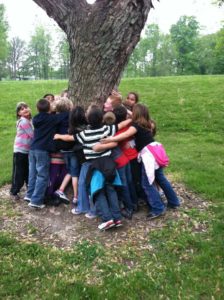Why Teach Outside?

PLT is a great organization with wonderful programs. You should schedule them to come to your school and reap the benefits of their knowledge, wisdom, and resources. I hope this article taken from PLT encourages you to teach outside every opportunity you have. After all, it is our home, and kids love to be outdoors.
WHY TEACH OUTSIDE?
Project Learning Tree
Quick—what’s your favorite Project Learning Tree activity? Now think again. Where do you do it?
If you answered “indoors,” reflect… could you have done it outdoors? Even reading a story, like “In the Forest of S.T. Shrew” found in PLT’s Activity Guide8, takes on many added dimensions, if simply read outdoors.
We teach indoors for lots of reasons. After all, someone built us a building. Indoors feels secure. There are four walls and a ceiling. It never rains, snows, or darkens, and it’s always a comfortable temperature. We have desks, pencils, Smart Boards, and electrical outlets. However, it can deprive us of stimulation.
Why Teach Outside?
Intellectually, we’re aware of benefits of learning outside the four walls of the classroom. A growing body of research reveals the significance of early experiences with nature as an important factor in developing environmental awareness (Taylor and Kuo, 2006; Orr, 2004). A quick glance at the voluminous research abstracts listed on the Children and Nature network reveals several research studies that glow about how nature, hands-on learning, and authentic experiences can:
-
Improve test scores, attendance, attitude toward learning
-
Positively affect a child’s physical, social, interpersonal, and aesthetic development
-
Alleviate symptoms of ADHD and ADD
-
Help ELL learners learn new vocabulary
-
Improve child health
-
Allow children who learn differently from others to become leaders and shine
With benefits like these, teaching outside should be a “no-brainer.” Yet most teachers don’t go outside with their students. Why?
Barriers to Teaching Outside
Cynthia C. Gardner from Lander University in South Carolina wrote a paper called “Why Some Teachers are not using the Schoolyard Environment.” (For a copy, contact cgardner@lander.edu.) She had taught at a South Carolina school that had three beautiful designated outdoor teaching areas (a pine forest, a pond, and a wetland), yet observed very few teachers using those spaces. To find out why, Gardner distributed 50 surveys to teachers of kindergarten through grade 5. She received 35 responses. A quick summary of the results:
-
Sixty-six percent (23 teachers) never used the pond area; 37% (13 teachers) never used the pine forest; and 40% (14 teachers) never used the wetland.
-
Most used the outdoor areas 1-5 times a year. Only one teacher used it 6-10 times a year.
-
Reported levels of comfort teaching outdoors: low 31% (11 teachers); medium 40% (14 teachers), high 29% (10 teachers)
-
Perception of importance of adding the natural areas into the curriculum: Not or somewhat important: 60% (21 teachers); important or very important: 40% (14 teachers)
Teachers were also asked to identify barriers to teaching outside. The barriers fell into five categories:
-
curriculum standards,
-
daily schedule,
-
supervision of children,
-
hazards, and
-
lack of knowledge.
Only the K-2 teachers cited “supervision of children” and “natural hazards” as barriers. Only grade 3-5 teachers cited “lack of knowledge.” Teachers from all grade levels cited the curriculum standards and the daily schedule.
While Gardner’s study focuses only on one school in South Carolina, I suspect her results are pretty similar elsewhere. I’ve worked with hundreds of teachers over the years. I’ve heard lots of excuses, concerns, and barriers to going outside. I could add a few more barriers to Gardner’s list:
-
kids aren’t properly dressed for the weather,
-
we “don’t have nature,” and
-
the teachers simply don’t like nature/cold/wet/wind/sun/snow/ticks/etc.
-
student-sitting-against-tree-in-snow-writing-poetry
Attend a PLT workshop and become comfortable teaching outdoors – in urban, suburban, and rural environments.
I know which teachers consistently take their students outside to learn, and have heard testimonials on the benefits of nature in academic settings. Find a mentor at a local nature center, through your state environmental education organization, or contact your state PLT program coordinator for help. Check out the many useful Appendices in PLT’s Envrironmental Experiences for Early Childhood guide, for example “Playing It Safe Outdoors”, “Taking Neighborhood Walks”, “Setting Up an Outdoor Classroom”, “Encouraging Unstructured Outdoor Play”, and more.

